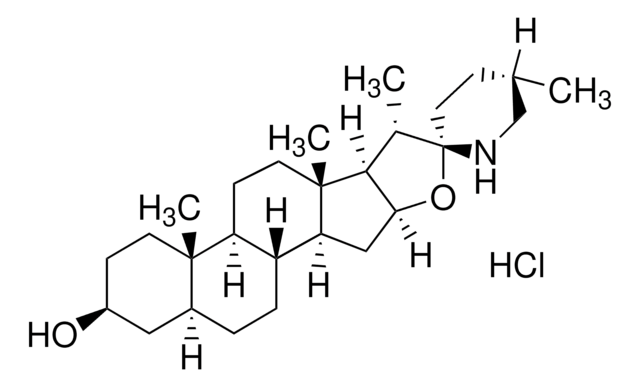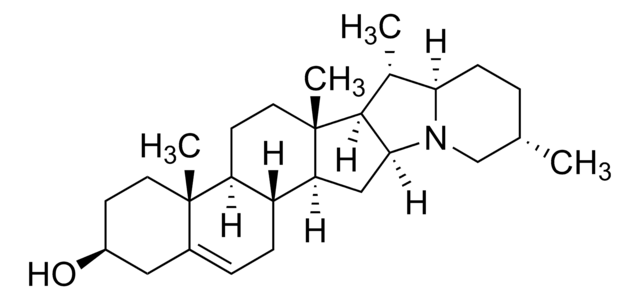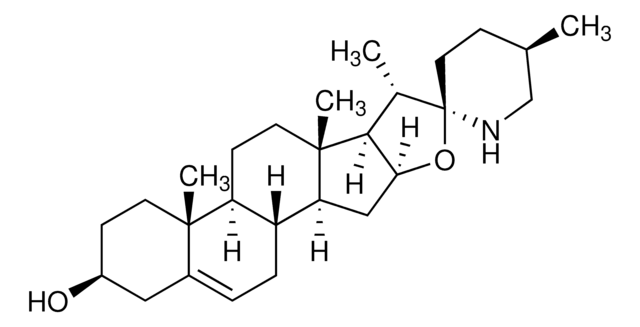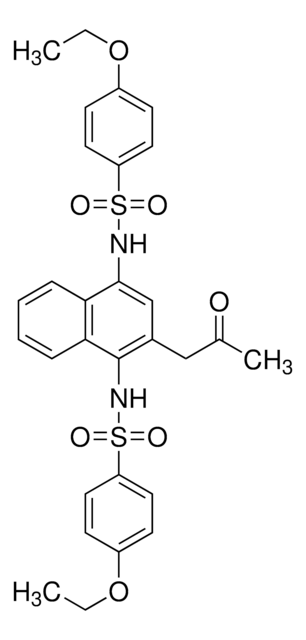T2909
Tomatidin -hydrochlorid
≥85%
Synonym(e):
3β-Hydroxy-5α-tomatidane hydrochloride, 5α-Tomatidan-3β-ol hydrochloride
About This Item
Empfohlene Produkte
Assay
≥85%
Lagertemp.
2-8°C
SMILES String
Cl[H].[H][C@@]12CC[C@]3([H])[C@]([H])(CC[C@@]4(C)[C@@]3([H])C[C@]5([H])O[C@]6(CC[C@H](C)CN6)[C@@H](C)[C@]45[H])[C@@]1(C)CC[C@H](O)C2
InChI
1S/C27H45NO2.ClH/c1-16-7-12-27(28-15-16)17(2)24-23(30-27)14-22-20-6-5-18-13-19(29)8-10-25(18,3)21(20)9-11-26(22,24)4;/h16-24,28-29H,5-15H2,1-4H3;1H/t16-,17-,18-,19-,20+,21-,22-,23-,24-,25-,26-,27+;/m0./s1
InChIKey
SXXHVPYRDFJKPG-XRWUXUKGSA-N
Suchen Sie nach ähnlichen Produkten? Aufrufen Leitfaden zum Produktvergleich
Allgemeine Beschreibung
Anwendung
- to evaluate its effect on nasopharyngeal carcinoma using cell proliferation and flow cytometry assay
- as a negative control in the non-specific inhibition on hedgehog signaling in hepatocellular carcinoma cell lines
- as a control for cell growth assay and expression studies in pancreatic cancer cells
Biochem./physiol. Wirkung
Signalwort
Warning
H-Sätze
Gefahreneinstufungen
Acute Tox. 4 Oral
Lagerklassenschlüssel
11 - Combustible Solids
WGK
WGK 3
Flammpunkt (°F)
Not applicable
Flammpunkt (°C)
Not applicable
Persönliche Schutzausrüstung
Eyeshields, Gloves, type N95 (US)
Analysenzertifikate (COA)
Suchen Sie nach Analysenzertifikate (COA), indem Sie die Lot-/Chargennummer des Produkts eingeben. Lot- und Chargennummern sind auf dem Produktetikett hinter den Wörtern ‘Lot’ oder ‘Batch’ (Lot oder Charge) zu finden.
Besitzen Sie dieses Produkt bereits?
In der Dokumentenbibliothek finden Sie die Dokumentation zu den Produkten, die Sie kürzlich erworben haben.
Kunden haben sich ebenfalls angesehen
Unser Team von Wissenschaftlern verfügt über Erfahrung in allen Forschungsbereichen einschließlich Life Science, Materialwissenschaften, chemischer Synthese, Chromatographie, Analytik und vielen mehr..
Setzen Sie sich mit dem technischen Dienst in Verbindung.














